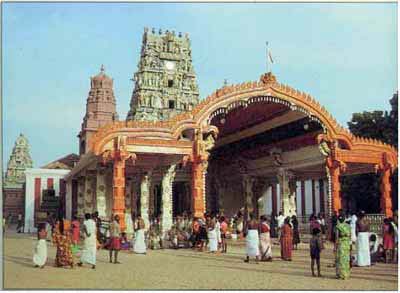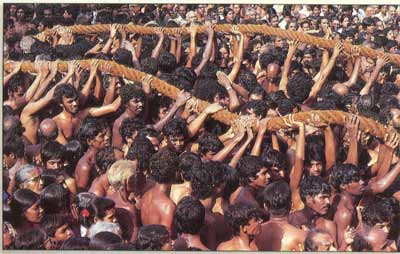|
| |||||||||||||||||||
Nallur Kumaran
by ShanmugapriyaHistorical BackgroundNallur was the capital of the old Jaffna kingdom where places of political, religious and cultural importance were built. These include the old Sankiliyan palace, Arumuga Navalar Adheenam, Chellappa Swami samadhi and Nallur Kumaran Temple to name a few. In 948 A.D, Chief Minister to Chola Kulangai Arya, called Bhuvanekabhahu, first built a temple for Lord Kumaran in Kurukkal Valavu in Nallur. In 1450, Senbaha Perumal, the General of Parakramabahu came from Anuradhapura to conquer Jaffna, and destroyed the temple. Regretting his action, in 1457, he tried to make amends by building the temple in Muthirai Chanthai. During the Portuguese invasion, it was again destroyed. In 1734 it was constructed again in Muthirai Chanthai. Under Dutch reign, in 1749, due to the efforts of Krishna Subbiah a Brahmin and Ragunatha Mapana Muthaliyar a government official, permission was granted to build the Kumaran temple in its original site in Kurukkal Valavu. The Muslim community inhabiting the premises was rehabilitated and the temple was built. Due to previous incidents, a simple style was chosen rather than a conventional temple. This is the present site of the temple. The TempleThe temple faces the east and exhibits an ornately carved five storied front Kopuram, 6 bell towers and a smaller gopuram. The entrance hall has an intricately designed arched ceiling, two gigantic, creatively carved teak doors studded with multitude of silver bells leading into the inner court. On either side of the doors stand two magnificently carved temple guards or dvarapalar. The inner hall displays, exquisitely embossed copper ornaments, contrasted against a vibrant orange wall. The holy sanctum housing the Vel is visible through an archway elaborately designed in shining copper. Rows of glittering oil lamps enhance the aesthetic quality of
To the south of the inner court are many other deities. The north eastern corner is referred to as "Chitamparam" and reveals a magnanimous portrait of the cosmic dancer Lord Shiva. To the north of the inner court is the Nanthavanam and Vasanta Mandapam. The eastern side displays the Yaga Mandapam. The south accommodates the teertha keni with a large exquisitely designed Vel strategically placed in the centre. Though the original Kumaran temple was constructed in accordance with Saiva Agamas, in later years decisions were taken to avoid constructing a stupi and adopt a mandalaya style. When attempts were made to rectify this, rumour has it that Lord Kumaran appeared in a dream to assure that the present format was to his liking. The temple is renowned for the meticulous manner in which pujas are conducted. Every day six pujas are conducted. The temple also conducts sadā utsava (daily festivity), sadā agni homa (daily fire homa) and sadā kāla (always at that particular time. Many attribute these religious practices for the increasing divinity of Nallur Kumaran temple. The FestivalsIn Sri Lanka and beyond, Nallur Kumaran is popularly known as Alankara Kanthan (Lord of exquisite adornment). The annual festival of Nallur Kumaran temple is conducted during July or August of each year for 28 days. It commences with the flag hoisting ceremony followed by Mancham, Kailaya Vahanam, Oru Muga Tiruvizha, Saparam, Ther and Teertham and the finale is Tiru Kalyanam. The preparation for the festival includes the entire village where residents living around the temple join in decorating their homes and streets with auspicious festive décor such as mango leaves, coconut strips, flowers, plantain trees and coconut flowers together with kolam designs depicting yantras associated with the deity. The highlight of the festival is the Ther chariot ceremony. It commences at Brahma Muhurtam when devotees from far and near gather to witness the glamorously attired Lord Shanmuga,
As though the heavens opened, the bells ring, conch blows, orchestra reverberates, confetti of flowers are strewn as tens and thousands of devotees throng the temple precincts to catch a glimpse of Lord Shanmuga and win His grace. ‘Haro-hara Haro-hara!' repeat the devotees as the deity arrives regally at the entrance surrounded by pious pujaris chanting mantras, with royal guards in attendance. As Lord Shanmuga steps out majestically, time; which never stops in Nallur temple, stands still for one moment, only to capture the beauty of the Lord as He accepts the confetti of lotus flowers showered by the devas of the second world. The Spiritual TeachersSpiritual awakening and the truth of oneness with God was taught by saints and sages. In Nallur, this authority was passed on to the Kailasa Parampara. The yogic lineage is traced back to a swami who lived in Mt. Kailasa (1770-1840) who later initiated Kadai Swami into the path of a siddhar line. He came to Sri Lanka from India and attained samadhi in Neeraviadi (1810-1875). Kadai Swami initiated Chellapa Swami as the next guru and made him sit by the Nallur Kumaran temple theradi so that people may get an opportunity to have his darshan. However, Chellappa Swami appeared as a madman and very few realised his divinity (1840-1914). This liberated soul, seated by the theradi was in communion with Nallur Kumaran and enjoyed an intense relationship. Chellappa Swami initiated Yoga Swami into the siddhar line. On one occasion, he meditated for 40 days on the steps leading to the ther, following which, as though drawn by the mystical, magnetic pull of Kumaran, he embarked on a pilgrimage to Kathirkamam (1872-1964). Yoga Swami revealed insights which are: In 1949, Yoga Swami initiated Subramanya Swami into the spiritual path. Subramanya was born in affluent America but had an imperative desire to tread the spiritual path. He came to Sri Lanka but later left for Hawaii to inaugurate the Hindu monastery (1927 to 2001). His disciple Velan Swami also visited Nallur but currently lives in Hawaii spreading Hinduism. PuranasHinduism rests on a wide range of Puranas, Vedas, Agamas including srutis (revelations) and smritis (inspiration). The Puranas are the sacred lore. Scholars are beginning to appreciate the deep psychological wisdom preserved and transmitted in the form of Puranic legends.
One aspect of the deity is Shanmuga, the energy of Lord Shiva. In Nallur, many devotees have had visions revealing a lingam buried below the deity Arumuga highlighting the principle: father is son. Puranas narrate, that devas harassed by demon Surapadma, supplicated to Lord Shiva and in His love for them, sent forth His energy into a pond in the form of six rays which manifested as six children and when held together mystically became the six headed Shanmuga. Shakti offered the Vel and the celestial army of which Shanmuga became King. On defeating Surapandara, the Lord made his enemy into the emblem of a cock in His flag and the peacock which became his vehicle. The other aspect of the deity is Dandayudhapani, the nirguna aspect free of maya. Puranas state, that sage Narada presented Lord Shiva with a mango, which was offered to the fastest of his sons to circuit the world. Ganesha circled Lord Shiva and Shakti and claimed the mango. Kumaran went round the world and on losing, renounced everything to become Dandayudhapani. Another aspect of the deity is the Kali Yuga Varada, the saviour of this yuga. His consort Teyvayani represents kriya shakti and Valli, iccha shakti and Kumaran gnana shakti. He is the one who destroys maya in His devotees. This is the saguna form of Kumaran. The Saviour
Devotees of the temple are of the view that Kumaran worship means, "avan arulal avan thal vananki" and "ennai thaduthu atkonda". Many narrate their experiences where the Lord had initially intervened in a crisis in their lives, consequently bringing about a change in attitude of the devotee, leading to spiritual insights and mystical experiences, finally confirming the truth of oneness of the self with God. The uniqueness of Nallur Kumaran is asserted as the magnetic connection he has with his devotees. In the last two decades, the Tamil community living in the peninsula has experienced intense hardship. In 1987, the temple premises were opened to accommodate refugees. In the 1990's a bomb scare in the temple, which later turned out to be a hoax, completely devastated the devotees. Over the years, bombs fell in the vicinity but none damaged the temple. In 1996, the temple was closed for three months and keys left with the dvarapalar while everybody in the vicinity evacuated. A young devotee calls out to her saviour: "We are roaming as
refugees, Arumuga, Velava, The devotional song captures the primordial feelings of fear and pain experienced by a child but also reflects the hope and trust the devotee places in her saviour namely Nallur Kumaran. The annual festival of 2003 registered the largest crowd ever, arriving from far and near, from Sri Lanka and abroad to affirm their faith, proclaim their beliefs, register their gratitude, to love and become one with Nallur Kumaran the Saviour. For more about Nallur Kandaswamy Kovil go to www.nalluran.com "Nallur Kumaran - a spiritual experience" | Sacred sites of Lanka map
|
| Living Heritage Trust ©2021 All Rights Reserved |







